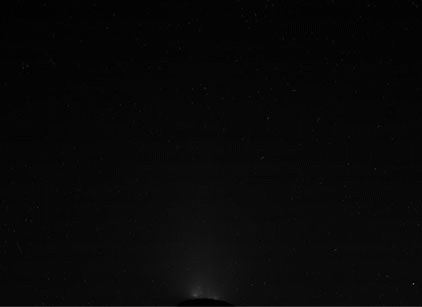
April 8, 2012
Credits: NASA/JPL/Space Science Institute - Credits for the additional process.: Elisabetta Bonora and Marco Faccin/Lunar Explorer Italia/IPF
|
Following the NASA - Voyager Spacecrafts encounters with Enceladus in the early 1980s, many scientists thought that this small moon of the Giant Gas-Planet Saturn could still have been geologically active; this, at that time, "scientific speculation" was based on its young, highly reflective Surface and its Spatial Location (such as near the core of the Saturnian E-Ring). However, based on the connection between Enceladus and the E-Ring in particular, it was also thought that this moon might have been, somehow (perhaps, through the Venting of Water Vapor, ice-crystals and dust from its interior), the source of the material forming the E-Ring itself. Unfortunately, a conclusive evidence that Enceladus was still geologically active and that it was the "supplier" of the material forming Saturn's E-Ring, was not achieved through the observations and data collected by the Voyager Spacecrafts. About 25 years later (such as in the AD 2005), thanks to data collected from a number of instruments onboard the NASA - Cassini Spacecraft, Cryovolcanism (such as an eruptive phenomenon where Water, Mud and other Volatiles are the materials erupted, instead of Rocks) was discovered on Enceladus. The first Cassini sighting of a Plume of Icy Particles above Enceladus' South Pole came from the Imaging Science Subsystem (ISS) frames taken in January and February 2005 (let's not forget that the - actually extremely remote, in our opinion - possibility the Plume was just a camera artifact, stalled an official announcement for quite some time). Afterwards, more data collected from the Magnetometer during the February 17, 2005 encounter, provided a hint that the feature might be real, when some evidence of an Atmosphere surrounding (in a really uneven way, as we shall see later) this small Saturnian moon was found. In particular, the Magnetometer observed a power increase of the Ion Cyclotron Waves existing near Enceladus (note: these Waves are produced by the simple interaction between Ionized Particles with Magnetic Fields and their frequency can be used to identify the nature of the Particles themselves - which, in our case, were Ionized Particles of Water Vapor). During the next two encounters, the Magnetometer Team determined that the Gases present in Enceladus's Atmosphere were concentrated over its South Polar Regions, with Atmospheric Density away from the South Pole being much lower. The Ultraviolet Imaging Spectrograph (UVIS) confirmed this result by observing two Stellar Occultations during the February 17 and July 14 encounters. Unlike the Magnetometer, though, the UVIS failed to detect an Atmosphere above Enceladus during the February encounter (when it looked for an evidence of it over the Equatorial Regions of the moon); on the other hand, the UVIS did detect the existence of Water Vapor over the South Polar Regions of Enceladus during the encounter of July. In fact - and absolutely fortuitously -, the Cassini Spacecraft flew right through this Gas Cloud during the July 14 encounter, allowing instruments like the Ion and Neutral Mass Spectrometer (INMS) and the Cosmic Dust Analyzer (CDA) to directly sample the plume. The INMS measured the composition of the Gas Cloud, detecting mostly Water Vapor, as well as minor components like Molecular Nitrogen, Methane, and Carbon Dioxide. The CDA, on its part, detected a "large increase in the number of particles near Enceladus", confirming that the small moon was the primary source of the material forming the Saturnian E-Ring. Furthermore, the analysis of the data collected by the CDA and INMS suggested that the Gas Cloud that Cassini flew through during the encounter of July, and then observed from a distance with its Magnetometer and UVIS, was actually a Water-rich Cryovolcanic Plume, originating from Vents located near the South Pole of Enceladus. Visual confirmation of the Venting finally came in November 2005, when the ISS (Imaging Science Subsystem) imaged Geyser-like Jets of Icy Particles rising from the moon's South Polar Region. Additional data were also acquired during a Fly-by that took place on March 12, 2008. The data collected from this further Fly-by revealed the existence of additional chemicals in the Plume, including Simple and Complex Hydrocarbons such as Propane, Ethane, and Acetylene. Needless to say, all this unbelievable findings raised even more the possibilities for the existence of some form of Indigenous Life beneath the Surface of Enceladus. The composition of Enceladus' Plume, as measured by the INMS instrument onboard the Cassini Spacecraft, resulted to be similar to the one of most Comets. A curiosity: Mimas, another satellite of Saturn, is a geologically dead Celestial Body, even though it experiences much stronger Tidal Forces than Enceladus does. Then, why Mimas is "dead" while Enceladus is still "alive and well"? An answer to this - just apparent - paradox can be found by applying to this Cosmic Scenario several Models of Tidal Heating that predict a low-energy Thermal State for Mimas and an excited, high-energy Thermal State for Enceladus, despite the fact that Enceladus orbits much farther away from Saturn than Mimas. |
News visualized: 705 times

